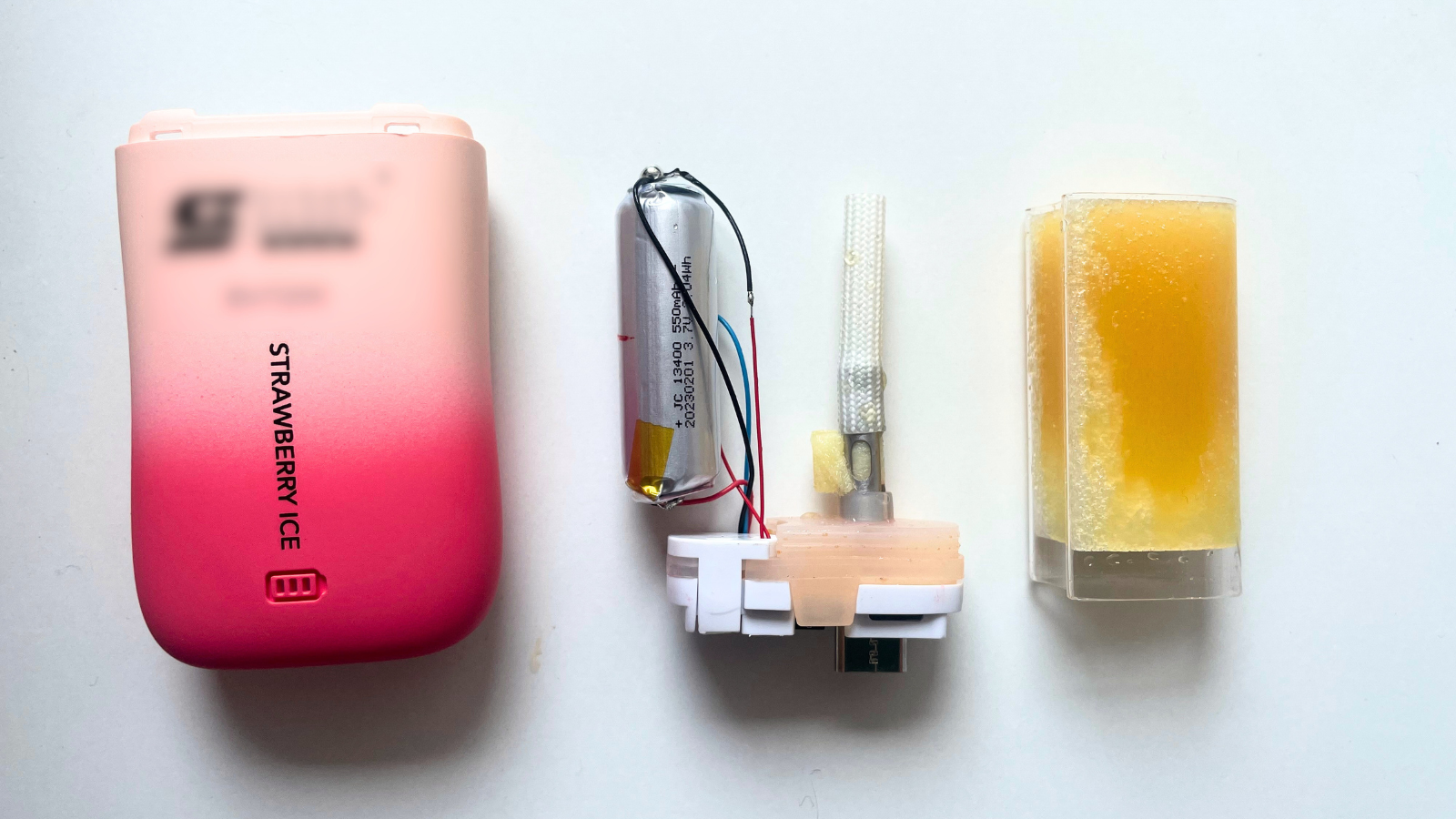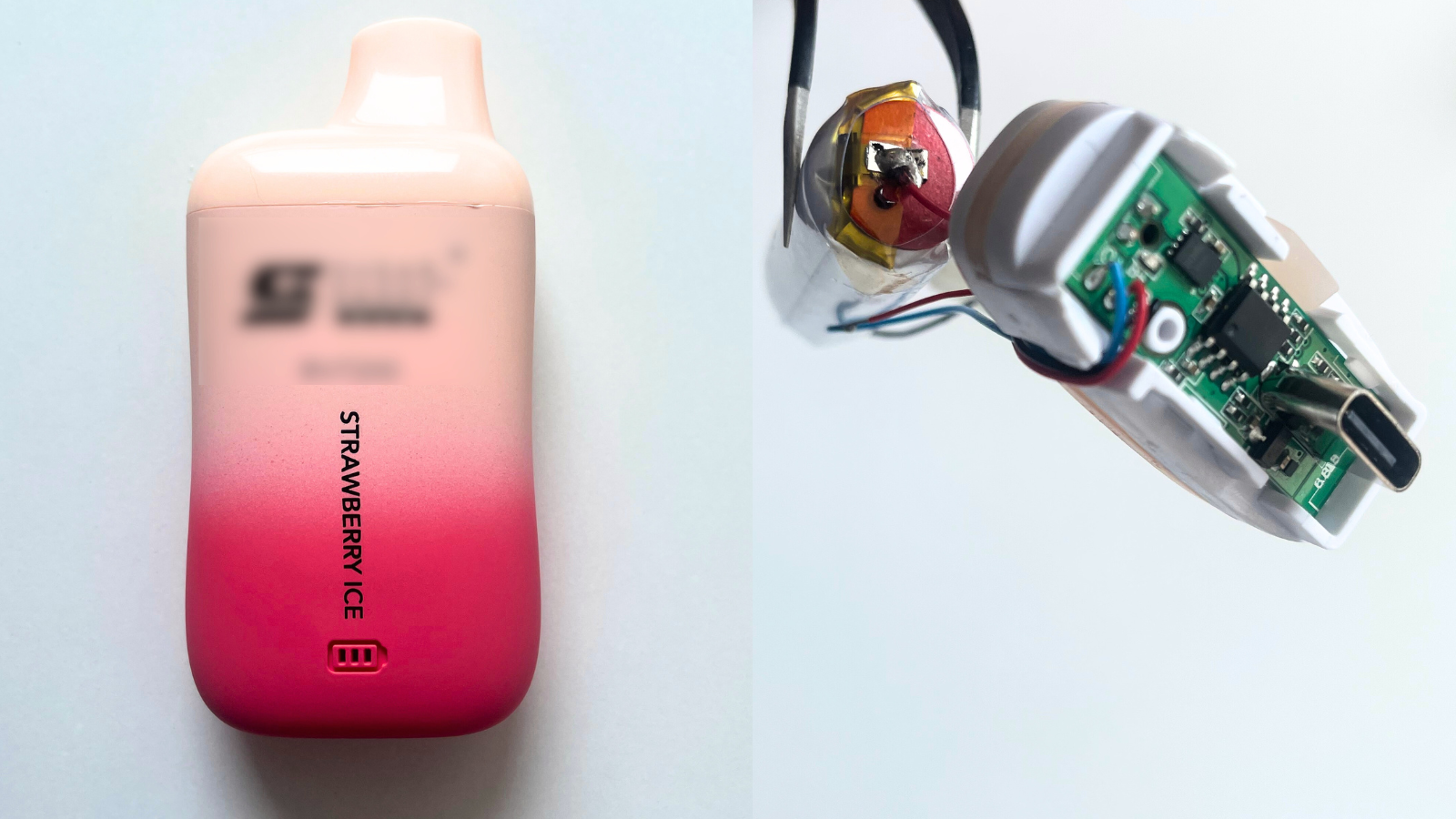
Vape Waste: The environmental harms of disposable vapes
U.S. throws out 4.5 disposable vapes per second
Vape Waste poses a growing environmental threat. According to CDC Foundation sales estimates, lining-up the disposable vapes sold in a year would stretch for 7,000 miles—long enough to span the continental U.S. twice. Because there is no standard legal way to recycle these products, many users just toss them.

Downloads
Nothing used for a day or two should pollute our environment for hundreds of years. While we know about the waste from single-use plastics, disposable electronics are often overlooked. It offends common sense to routinely junk some of the most intricately complex objects humans have learned to produce with their layers of integrated circuits, scarce and toxic metals, and world-spanning supply chains. With e-waste the fastest growing waste stream in the U.S. the rate at which we dispose of electronics is not sustainable.
One product stands apart as being particularly harmful to our environment and public health—disposable vapes. Vapes, also known as e-cigarettes, are handheld battery powered electronic devices with heated metal coils that vaporize a liquid containing nicotine or cannabis products, known as e-liquid. Nicotine is the famously addictive stimulant found in tobacco that gives smokers a dopamine hit, and makes quitting difficult.
Much has been made of the public health harms of disposable vapes, but this report aims to understand their effects as hazardous electronic waste. It doesn’t make any sense to manufacture electronics with rechargeable batteries, ship them across the world, and throw them out within a few days.
Disposable vapes are single-use products powered by the same rechargeable lithium-ion batteries used in electric cars and iPhones. However, unlike traditional vapes, they’re designed to be thrown out after use. That’s because while some can be recharged with a USB cable, once they run out of the included e-liquid they can’t be refilled. They’re wasteful, harmful, and trending.
After the Food and Drug Administration’s (FDA) February 2020 crackdown on flavored nicotine e-liquid cartridges for reusable vapes, sales of disposable brands increased 196.2% by March 2023, according to the CDC Foundation. The FDA’s decision prohibited the sale of flavored pre-filled nicotine vape cartridges exemplified by popular brand JUUL, but didn’t mention disposable vapes. This sin of omission created a gray market and by March sales of disposable products increased to 11.9 million units a month and have overtaken cartridges market share at 53% of vape sales. At this rate, we throw out 4.5 disposable vapes per second.
Few products are as harmful and popular as disposable vapes. We shouldn’t tolerate any disposable electronics, especially products that trash our environment and public health. This report examines the environmental effects of disposable vapes and includes recommendations to kick our addiction to these damaging products.

Annual vape waste stretches for over 7,000 miles, and it’s harming our oceans
According to CDC Foundation sales estimates, lining-up the disposable vapes sold in a year would stretch for 7,010 miles—long enough to span the continental U.S. twice. This vape waste is becoming more common while cigarette butts become less common as the trash that litters our beaches and waterways. It seems we’ve gone from bad to worse. While cigarette pollution takes up to 10 years to degrade, disposable vapes are non-biodegradable and “endanger ocean creatures that inadvertently consume the plastics.” Who looked at cigarette butts polluting our beaches and thought, “how can I make a product that will more effectively trash our oceans by never decomposing?”
We can’t recycle our way out
Electronics often contain hazardous materials such as the heavy metals lead and mercury. According to the UN, “recycling activities are not keeping pace with the global growth of e-waste.” The agency’s report found just 9.4% of e-waste is recycled in the Americas. It’s not just a capacity problem. We don’t have the technology to take complex products such as a disposable vape and magically melt them back into their component parts. We might never.
There is no standard legal way to recycle disposable vapes
Most spent disposable vapes will never face the challenges of recycling because they aren’t properly collected as e-waste. According to the Truth Initiative’s report:
Currently, there is no standardized way to recycle e-cigarettes in the U.S. Starting in 2019, the Drug Enforcement Agency (DEA) began accepting e-cigarette devices and cartridges during their annual National Prescription Take Back Day, although the DEA cannot accept devices containing lithium ion batteries.”
With no standard legal way to recycle disposable vapes, and the already low e-waste recycling rate of less than 10%, the vast majority of these products will end up in landfills or our waterways after they run out of juice.
Vape waste contains plastics, electronics, and chemical waste
Disposable vapes are encased in plastic shells that never fully degrade. They follow in the footsteps of other environmentally harmful single-use pod products, such as coffee pods, or even pod-using hair dye.
Due to the nicotine e-liquid used in these products, vape waste can’t be recycled with other plastics because the substance is defined by the EPA as an acute hazardous waste.
Disposable vapes can’t be reused, they can’t be recycled properly, and they can’t legally be thrown in the trash. What are consumers supposed to do with these products? Is it any wonder they’re an environmental threat?
Critical metals needed for electronics such as lithium are finite. Why are we throwing them out?
The lithium used by the batteries in the disposable vapes sold every year weighs 23.6 tons, equivalent to the lithium needed to create batteries for 2,600 electric vehicles. Tech like vapes require metals such as cobalt, platinum, gold and rare earth elements. Mining for these minerals is destructive. These metals are not infinite, and at some point we’ll run out.
Recommendations
We shouldn’t tolerate any disposable electronics and disposable vapes are easily the worst of the bunch. These products harm our health and environment. They waste the finite resources needed for manufacturing new technology. The only solution is a ban.
Federal enforcement
At the federal level, the FDA should enforce their rules against the sale of unauthorized disposable vapes. Enforcement has been growing to meet the scale of the problem, as “[f]rom January 2021 through May 2023, FDA issued more than 560 warning letters to firms for manufacturing, selling, and/or distributing new tobacco products without marketing authorization from FDA.” These actions are a strong start, but findings show these products are still ubiquitous and easy to buy. The environmental harms of disposable vapes should add urgency to the FDA’s enforcement and should foreclose authorization of any future proposals to sell disposable vapes.
Federal legislation
Given the extent of the issue, elected officials have a role in solving this problem. U.S. Representative Sheila Cherfilus-McCormick from Florida’s 20th congressional district introduced H.R.901, the Disposable ENDS Product Enforcement Act of 2023. This February 9, 2023 bill would, “require the Food and Drug Administration to prioritize enforcement of disposable electronic nicotine delivery system products.” The FDA categorizes vapes as ENDS (electronic nicotine delivery systems). Congress should pass this law and provide the FDA with the resources needed for enforcement.
State legislation
State lawmakers such as California Assemblymember Luz Rivas are introducing similar bills. AB 1690 would “prohibit a person or entity from selling, giving, or furnishing to another person of any age in this state a single-use electronic cigarette.” While many states and cities have banned flavored vapes, few have completely banned vapes, and none have explicitly targeted disposable products. Flavor bans which replicate the same sin of omission perpetrated by the FDA have allowed the disposable gray market to thrive. More states and cities should follow their mandates to protect health and environment by definitively banning disposables. New York Assemblymember Rosenthal has also introduced A01598 which would establish an e-cigarette recycling program, requiring retailers to accept used devices to be sent back to the manufacturers to be properly recycled.
Retailers
Convenience store and gas station retailers shouldn’t sell disposable vapes. These harmful products have no place on our store shelves. 7-Eleven locations, and gas company convenience stores with the Shell, Chevron, BP, Sunoco, Citgo, Mobil, Marathon, Exxon, Valero, and Conoco brands have all received warnings from the FDA, “for selling unauthorized tobacco products, specifically Elf Bar and Esco Bars vape products.” These national chains should hold franchisees and local locations accountable with a zero-tolerance stance.
Conclusions
We can’t afford to manufacture, sell, use, and toss disposable electronics. Throwing out rechargeable lithium ion batteries after one use doesn’t make any sense.
It’s true that nothing we use for only a day should pollute our environment for hundreds of years. As we move away from other disposable products such as single-use plastics, we should be aware of the growing number of electronic products that are similarly unsustainable.
Even harmful plastics have important medical uses. Disposable vapes on the other hand are both harmful and useless. Beyond their unsustainable design, even their intended use is damaging.
Some things are too harmful and useless to be tolerated in our society. We shouldn’t manufacture, use, or sell disposable vapes. Disposable vapes might be the worst product ever invented. Let’s kick our addiction to disposability and use products designed to last.
Topics
Authors
Lucas Gutterman
Director, Designed to Last Campaign, U.S. PIRG Education Fund
Lucas leads PIRG’s Designed to Last campaign, fighting against obsolescence and e-waste and winning concrete policy changes that extend electronic consumer product lifespans and hold manufacturers accountable for forcing upgrades or disposal.
Find Out More

Fixed for the Holidays

